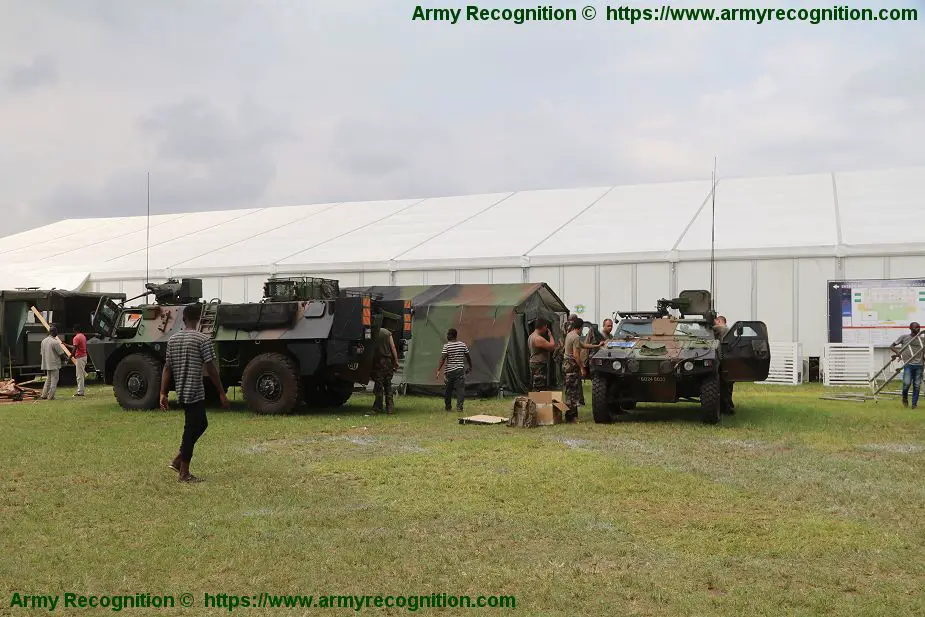With the Security and Defense Exhibition ShieldAfrica 2019, during three days from the 22 to 24 January, Abidjan the capital of Côte d'Ivoire will be the center of the world for the security and defense industry. ShieldAfrica is an opportunity for top African governmental and military delegations to meet international manufacturers offering latest solutions and innovations of military and security equipment.

French soldiers with combat vehicles at ShieldAfrica 2019, defense and security exhibition in Abidjan, Côte d'Ivoire, January 21, 2018. (Picture source Army Recognition)
While the organisation of the event evolves, ShieldAfrica remains an African exhibition, designed by African people and tailored to African countries. Within the Ivorian company COGES Africa, the alliance between the exhibition's founders and the organisers of Eurosatory, the sector's world-leading exhibition, gives ShieldAfrica an international dimension and guarantees continuity with previous years while showing respect for the particular features of Africa.
In the face of new security challenges and growing insecurities, ShieldAfrica helps finding and developing African solutions to peace and security issues. Côte d’Ivoire government support the development of ShieldAfrica, to make it a must event for everyone keen to further our continent's development and build a safer Africa.
According to the SIPRI (Stockholm International Peace Research Institute), military expenditure in Africa was $42.6 billion in 2017. This is a marginal decrease of 0.5 per compared to 2016. Despite the recent decrease in military spending, African military spending is 28% higher than it was 10 years ago.
Military spending in North Africa fell by 1.9 per cent between 2016 and 2017 to an estimated $21.1 billion. This was the first annual decrease in military spending in the subregion since 2006. Nonetheless, spending in 2017 was 105 per cent higher than in 2008. Algeria, Africa’s largest spender, decreased its military expenditure by 5.2 per cent between 2016 and 2017 to $10.1 billion. This was the first annual decrease in its military spending since 2003 and only the second annual decrease since 1995. The decline in Algeria’s military expenditure in 2017 was probably related to low oil and gas revenues in recent years.
Military expenditure in sub-Saharan Africa in 2017 was $21.6 billion, up 0.9 per cent from 2016 but 6.8 per cent lower than in 2008. A substantial surge in Sudan’s military expenditure in 2017 (by 35 per cent to $4.4 billion)—mainly due to intensified fighting between the Sudanese Government and rebels—drove the upward trend, but this was partly counteracted by decreases by three of the four largest spenders in the subregion: Angola, Nigeria and South Africa. Principal of those was the continued drop in Angola’s military expenditure (by 16 per cent) as part of government spending cuts. While Angola was the largest military spender in sub-Saharan Africa in 2014 with 26 per cent of the subregional total, it fell to third in 2017 (with 14 per cent of the total), behind Sudan and South Africa.
Nigeria’s military expenditure fell for the fourth consecutive year in 2017, by 4.2 per cent to $1.6 billion, despite continued military operations against Boko Haram. Military spending in South Africa, the second largest spender in sub-Saharan Africa, has stabilized at around $3.6 billion per annum since 2012. Its military spending decreased marginally in 2017, by 1.9 per cent. There were also notable cuts in military spending in 2017 in South Sudan (–56 per cent), Chad (–33 per cent), Mozambique (–21 per cent) and Côte d’Ivoire.
The decline in Côte d’Ivoire’s military spending, the first annual decrease since 2013, was the result of the sharp drop in world prices for cocoa, the country’s main export. In South Sudan, despite the ongoing conflict, the worsening economic conditions led to further reductions in military spending.














